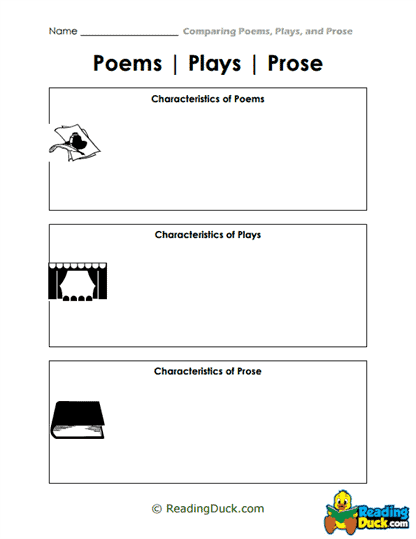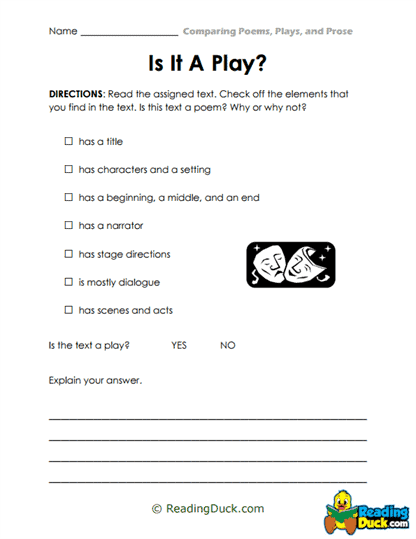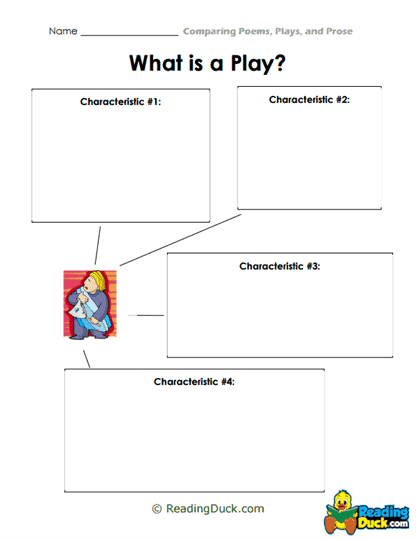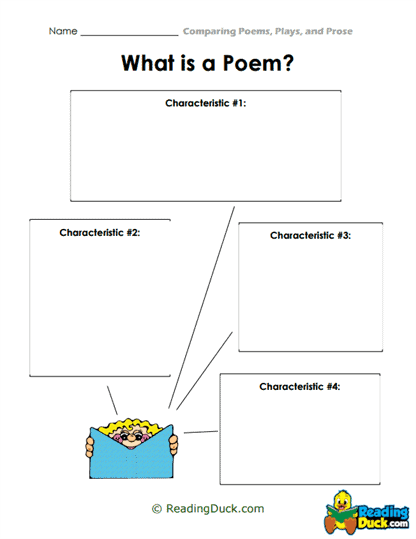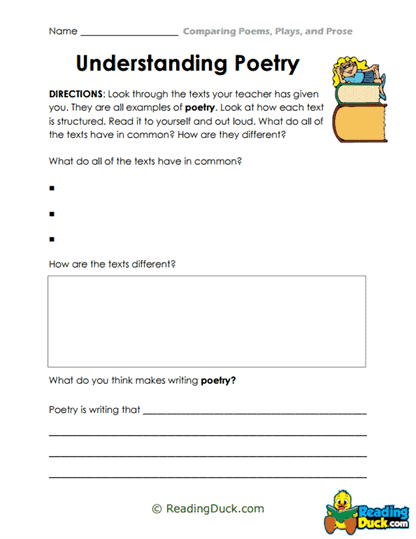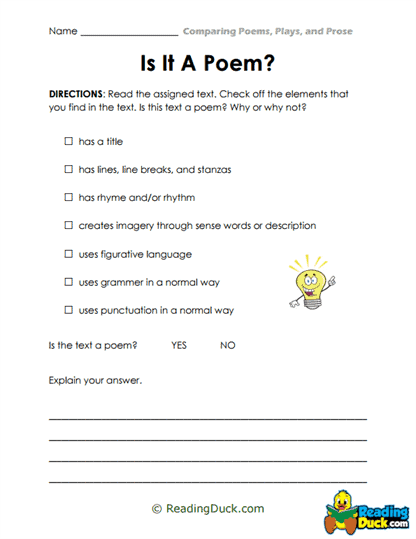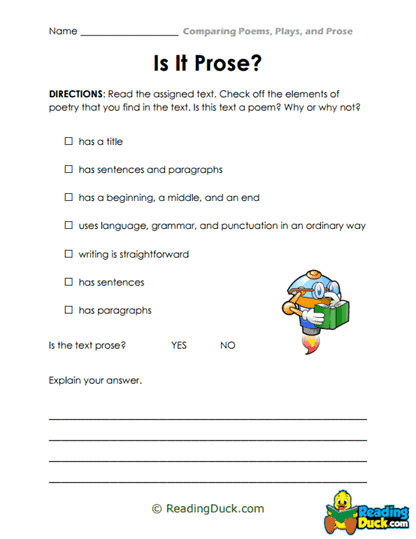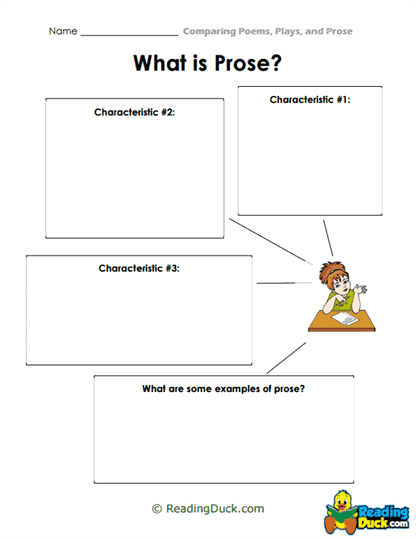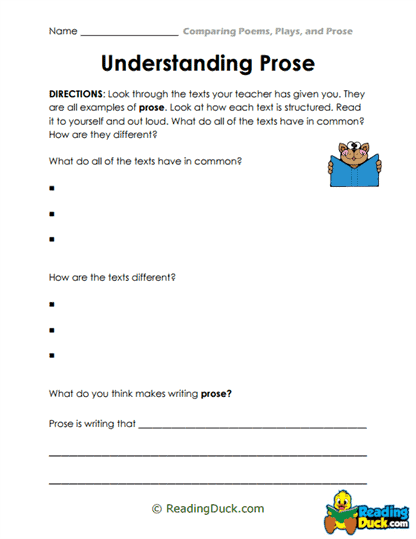Comparing Poems, Plays, and Prose Worksheets
About Our Comparing Poems, Plays, and Prose Worksheets
Our Comparing Poems, Plays, and Prose Worksheets are designed to help students explore the distinct qualities of these three major forms of literature, as well as to analyze and appreciate the similarities and differences between them. These worksheets provide students with a comprehensive approach to understanding how each genre conveys meaning, emotion, and narrative, while building essential skills in comparison, analysis, and critical thinking.
Available in PDF format, these worksheets are easy to download, print, and integrate into classroom lessons or home study sessions. Each worksheet comes with a downloadable answer key, providing teachers and parents with an accessible way to assess student progress. Whether used individually or as part of a larger lesson plan, these worksheets offer a flexible and engaging tool for developing deeper literary understanding.
Exploring the Distinctions Between Poems, Plays, and Prose
Poetry, drama (plays), and prose are three fundamental literary forms that differ in structure, style, and purpose. Understanding the unique characteristics of each genre enables students to grasp how writers use different tools to convey their messages and engage readers. These worksheets guide students through this exploration, helping them recognize how tone, rhythm, dialogue, and narrative flow are used differently across genres.
- Poetry: Known for its concise language, vivid imagery, and emphasis on sound and structure, poetry often uses techniques like meter, rhyme, and symbolism to evoke deep emotional responses. Through the worksheets, students will examine how poets compress meaning and explore themes in fewer words while also creating layers of interpretation.
- Plays (Drama): Plays use dialogue and stage directions to tell a story primarily through spoken interaction between characters. The worksheets help students analyze how plays rely on conversation, performance, and visual elements to communicate themes, emotions, and character development. Understanding how playwrights use structure (acts, scenes) and dramatic devices (monologues, asides) is also a key focus.
- Prose: Prose, which includes novels, short stories, and essays, offers a more straightforward narrative approach. The worksheets introduce students to the pacing, character development, and detailed descriptions that prose allows, helping them compare how prose differs from poetry and plays in building a world or telling a story.
By comparing these forms, students will gain a holistic understanding of how writers choose different methods of expression depending on the desired impact and audience.
Building Core Writing and Critical Thinking Skills
Our Comparing Poems, Plays, and Prose Worksheets are not just about recognizing differences—they also help students sharpen their writing and analytical abilities. Through these worksheets, students will:
- Analyze literary devices: Students learn to identify and compare the use of literary elements such as symbolism, metaphor, irony, and dialogue in each genre. This practice strengthens their ability to recognize how these elements function within different forms.
- Develop comparative writing skills: The worksheets encourage students to organize their thoughts clearly, construct well-supported arguments, and write essays that compare and contrast literary works effectively.
- Critical thinking: These worksheets challenge students to think deeply about why an author chose a particular form and how it affects the reader or audience's experience. By analyzing these choices, students enhance their ability to interpret and evaluate literary works critically.
For example, students might compare how a theme like love or conflict is explored in a poem versus a play. This comparison requires them to not only recognize thematic similarities but also analyze how different techniques—such as the use of soliloquies in a play or metaphor in a poem—shape the reader’s understanding of the theme.
Encouraging Creativity and Independent Thinking
These worksheets encourage students to think creatively and explore literature beyond surface-level comparisons. By analyzing poems, plays, and prose side-by-side, students are prompted to consider how the form of a piece influences the reader's experience and how different artistic choices affect interpretation. This type of exploration fosters both creative thinking and imaginative problem-solving, encouraging students to think critically about how literary elements can be manipulated to convey meaning.
The worksheets are designed to be flexible, allowing teachers to adapt them for a variety of learning paces and student abilities. This adaptability ensures that students of different skill levels can engage meaningfully with the material.
Differentiated Learning:
- For younger students: Focus on simple comparisons, such as identifying basic structural differences between a poem and a short story, allowing students to grasp foundational concepts.
- For advanced students: Explore more complex topics, such as comparing the emotional impact of a soliloquy in a Shakespearean play to the rhythm and mood in a modern poem.
These worksheets support independent study, offering students opportunities to work at their own pace and reflect on their learning. With the downloadable answer keys, students can review their progress and assess their understanding, making these worksheets an effective tool for home learning.
Integrating These Worksheets Into Broader Projects
The Comparing Poems, Plays, and Prose Worksheets are versatile and can be easily integrated into larger units or long-term projects. By building a strong foundation in comparative analysis, these worksheets help prepare students for more advanced assignments, such as essays, presentations, or creative projects.
Integration Ideas:
- Essay Writing: These worksheets serve as excellent preparation for comparative essays, where students must analyze how themes, characters, or narrative structures differ across literary forms. For example, students might write an essay comparing how the theme of fate is handled in a poem versus a play.
- Literary Analysis Projects: Teachers can use the worksheets as part of a larger literary analysis unit, encouraging students to examine the stylistic differences between genres and how those differences affect reader interpretation.
- Creative Assignments: Encourage students to rewrite a scene from a play as a poem or transform a narrative prose passage into a dramatic script. This type of creative project allows students to apply their understanding of genre while developing their own artistic voice.
These activities not only reinforce the concepts introduced in the worksheets but also allow students to apply their learning in practical and engaging ways. As a result, they develop a deeper, more personal connection to the literature they are studying.
Promoting Engagement and Active Learning
The interactive and thought-provoking nature of the Comparing Poems, Plays, and Prose Worksheets keeps students engaged and motivated. These exercises are designed to spark curiosity and encourage active participation in the learning process. By prompting students to consider multiple perspectives and literary techniques, the worksheets ensure that students remain involved and interested.
Engagement Benefits:
- Interactive Learning: Students actively engage with the material as they work through comparative exercises, enhancing their ability to analyze and synthesize information.
- Independent Mastery: These worksheets are ideal for independent learning, as students can complete them at their own pace and use the answer keys to track their progress.
- Critical Engagement: By asking students to think deeply about how different forms of writing function, the worksheets promote deeper engagement with the texts and foster a lifelong appreciation for literature.
Complementary Activities for Extended Learning
To deepen students’ understanding and reinforce the skills practiced in the worksheets, teachers can incorporate complementary activities that encourage further exploration of poems, plays, and prose.
Suggested Activities:
- Group Discussions: After completing a worksheet, students can engage in group discussions to explore how their interpretations of a poem differ from a play or prose text. This allows for collaborative learning and multiple perspectives.
- Performance Projects: Assign students a scene from a play and a poem, then ask them to perform both, emphasizing how performance and spoken delivery change the audience's experience of the text.
- Creative Writing Challenges: Have students create their own literary pieces in two different genres—such as turning a short story into a poem—to apply what they’ve learned about structure, language, and form.
- Visual Comparisons: Encourage students to use visual aids, like Venn diagrams or charts, to map out the differences and similarities between a poem, a play, and prose. This approach helps visual learners solidify their understanding.
These activities not only extend learning but also foster collaboration, creativity, and critical thinking, ensuring a well-rounded educational experience.
Ideal Grade Levels and Adapting for Different Learning Environments
The Comparing Poems, Plays, and Prose Worksheets are suitable for a wide range of grade levels, offering flexibility and adaptability for various classroom settings.
Recommended Grade Levels:
- Middle School (Grades 6-8): Introduce students to the basic structural differences between poems, plays, and prose. Focus on simpler comparisons, such as how dialogue in a play differs from narration in a short story.
- High School (Grades 9-12): Engage in more in-depth analysis, comparing complex themes, literary devices, and stylistic choices across genres. These worksheets prepare high school students for more advanced literary analysis and essay writing.
The worksheets can be tailored to fit different learning environments, whether in traditional classrooms, homeschooling settings, or independent study. Teachers can easily modify the difficulty level or focus of the worksheets to meet the specific needs of their students, ensuring that each learner is challenged appropriately.
Conclusion
Our Comparing Poems, Plays, and Prose Worksheets provide an essential resource for students looking to develop a deeper understanding of literary forms while honing their writing and analytical skills. With their adaptable structure, engaging content, and focus on critical thinking, these worksheets offer a valuable tool for teachers, parents, and students alike. By fostering creativity, encouraging comparative analysis, and promoting independent learning, these worksheets help students master the art of literary comparison and apply their knowledge in meaningful, real-world contexts.
